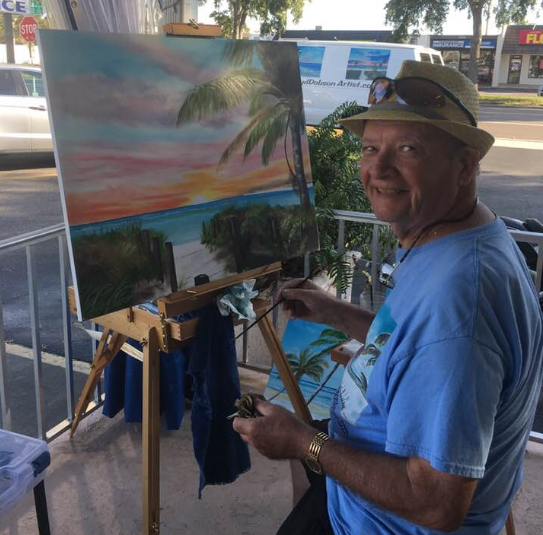Tag: arts & craft shows
How Many Paintings Are Needed For Your Art Show?
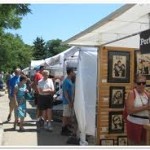


How Many Paintings Are Needed For Your Art Show? This a question that is predicated on the space that you will have available. Most outdoor art events spaces are limited between 10’x10′ and 10’x20′ spaces. The larger meaning you would register for two areas adjacent to each other.
My suggestion would be to have three different sizes of your art work. Large, medium and small as an example. With different sizes you are able to accomplish a couple of things. One is an exhibit that is more appealing and secondly allowing you to have several price points. A good rule of thumb would be between 20 to 30 pieces per 10’x10′ space. Another factor will be determined by the time you have to create the work needed.
study your exhibit space carefully and take pictures and measure the space. Make a scale drawing either on paper or computer of the wall/exhibit space (I’m assuming for flat work) and use “to scale” shrunk down cutouts or paste ups of your work and then start playing around with the layout of what you will hang. You may be limited in the number of pieces just by available space alone. Also, will you have access to track lighting, ambient light only and so on.
If you don’t have enough art work of your own, a great idea is to share your booth space with another artist that complements your work, as well as your art work with theirs. My experience has shown me that when colaborating with a partner you become twice as smart and that results in great marketing strategies to help both you and your partner’s success in your art show.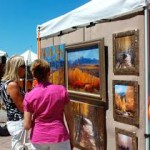
If you are passionate about your art and enjoy sharring your creative talents with the world, you will figure out a way to create enough art inventory for your art exhibits. So now back to the question, how many paintings are needed for your art show? The answer as you can see varies from show to show and the area you will have available.
How To Have Success At Art Shows
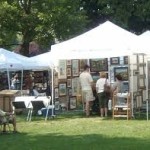
 How to have success at art shows. Like any business you need traffic and you need conversions, better known as buyers. One thing you must remember . . . It does not matter what business you are in! Whether you are in the art business, the restaurant business, the widget business or the fu-fu business. You are in the “People Business”
How to have success at art shows. Like any business you need traffic and you need conversions, better known as buyers. One thing you must remember . . . It does not matter what business you are in! Whether you are in the art business, the restaurant business, the widget business or the fu-fu business. You are in the “People Business”
So you have always wondered what it would be like to be an artist and show and sell your work around the country at weekend art shows? Here are some tips that can increase your chances of succeeding.
1) Go Visit Some Art Events First –
You may not always have the luxury of visiting each and every art show before you apply for acceptance. After all, if you visit before applying, you’ll have to wait another year to participate (if you are accepted) and most of us are not that patient. However, when you can visit the show first and talk to participating artists, you will get a feel for whether or not this is a show in which you wish to participate. Be up front with the artists that you talk with and ask a few questions. Most will be happy to answer your questions if they sense your honesty and sincerity and you don’t distract them from those who visit their booth.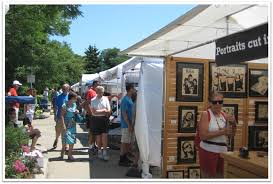
Some events that bill themselves as art shows or even arts and craft shows end up with a lot of questionable “art” booths that are not really art at all. If the “art” show has more than it’s share of artists who make foam rubber alligators on a coat hanger or rubber band gun crafters, it’s probably not that high quality of art show. That is not to say that there is not a place for these products. There are many large festivals that attract huge crowds that have all kinds of vendors from artists and crafters to cosmetic salespeople to sausage-on-a-stick vendors.
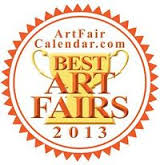 On the other hand, a juried event will elevate the level of quality work that is shown, which should attract an audience that has a greater appreciation for art. One such website for listings is www.ArtFairCalendar.com It may reduce the number of attendees, but those who do attend may be a more “qualified” audience. By qualified, I mean that they not only have a greater appreciation for art, but hopefully the means to purchase it if they like it.
On the other hand, a juried event will elevate the level of quality work that is shown, which should attract an audience that has a greater appreciation for art. One such website for listings is www.ArtFairCalendar.com It may reduce the number of attendees, but those who do attend may be a more “qualified” audience. By qualified, I mean that they not only have a greater appreciation for art, but hopefully the means to purchase it if they like it.
2) Be Consistent With Your Art Work –
Even though you may be good at every artwork you ever produce, your audience of potential purchasers/collectors will likely identify you with a particular subject, a color, a style, a medium, a method of presentation, etc. Show a lot of whatever you enjoy doing the most and a lot of what seems to be connecting with folks the most. A bunch of random paintings of various subject matter with no distinctive style or color pallet in cheap mis-matched frames will not likely hold a potential buyer’s attention for long, even if the paintings are good. A hodge-podge of sculptures that look like they were made by ten different sculptors will not likely enhance your reputation. 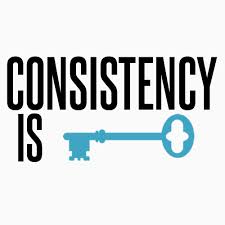
This randomness does not help to identify what you are all about. I’m not advocating that you never try anything new or experimental, but you must make your art memorable to gain any kind of following. Consistency is the key. Look at the work of some of the more successful artists that you admire. What ties their work together and identifies it as their own? Subject matter or theme, style (the way they paint or sculpt), choice of colors used, size, framing? Any and all of these characteristics may apply. Don’t copy their work, but learn from it. If you are doing work that connects with an audience, folks will seek you out to buy your art, even after the show is over. It’s happened to me many times.
CLICK HERE NOW or The Banner Below For The Secrets of Art Show Success + Getting Started At Art Fairs
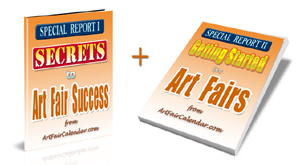
3) Have Several Price Points –
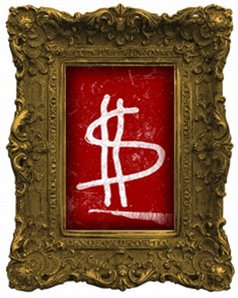
Whether you choose to show only originals, or limited editions, or a combination is often dictated by the show guidelines. Sometimes, it is entirely up to you. If you have a body of work that connects with viewers, it obviously would be desirable to sell some of it. If you limit your offerings to large, expensive (whatever that means to you) original works, your potential market will be smaller and you will eliminate a number of folks who, otherwise, might like to purchase.
That may be OK if your work is selling for the prices you want on a regular basis. However, my experience is that having artworks at several price levels makes it possible for purchasers/collectors to enjoy ownership of some of my art in the “now” until they are ready to move up to more collectible, thus more expensive and profitable, pieces. This might be achieved through offering a number of sizes of original works, offering print or sculpture editions in two or more sizes, having some limited editions and some less expensive open editions, or even offering gift type products such as note cards or calendars with your art reproduced on it (if the show allows it).
4) Have a Clean and Professional Looking Display Booth –
There are a few generally accepted artist booth set-ups that are used at most quality shows. The standard size booth is often a 10×10, so many canopies, or tents, are made to this size. EZ Up, Flourish, ShowOff, and a few others seem to be the most popular. As your inventory and sales increase, you can always add on for a double booth space, when available. Though some brands of tents come in a myriad of colors, a white top is recommended. Some shows won’t accept anything else. Choose the one that suits your budget and make sure it has adequate sidewalls and leg weights in the event of in climate weather. If you show long enough, you will experience in climate weather.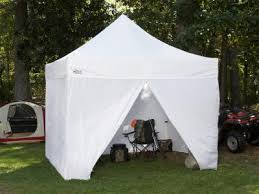
Have a tool box to contain such items as pliers, hammer, nylon connectors, wire, duct tape, clamps, small broom and other miscellaneous items that you may need over the course of the show. Once you have shown a few times, you will get an idea of what items are useful. Keep this and anything else that might distract from your art out of sight as much as possible.
5) Have Adequate Space For Your Potential Customers –
I have noticed that more people will actually come inside my booth exhibit and look longer if I stay outside my booth until I sense an interest in my work. I try to be very attentive, but I will only approach a visitor when I sense some kind of interest, however slight. Do not block your entrance by positioning yourself and your staff or friends and family where no one can walk in and look around.
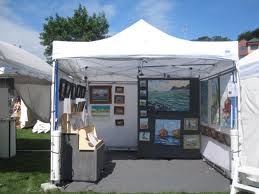
Even if there are two of you and each is sitting at the side near the front of your booth, there seems to be an invisible barrier through which visitors will not pass. I have seen other ideas of where the artist(s) position themselves to encourage better “booth visitation,” and in a larger booth than 10×10 I could see where sitting over to the side at the back of the booth might work well.
However, in my own personal booth I don’t want my face to compete with my art. At this point, I am only incidental to the art. I did the art and I answer any questions and take the money. Otherwise, I don’t want to get in the way. Yes, I want the customer to remember me, but I first want them to see my art. When you make a sale of any significance, follow up with a handwritten thank you note.
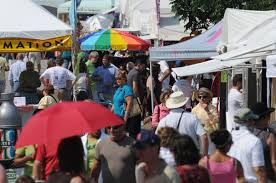
Showing and selling your work at outdoor art festivals is hard work often accompanied by some expensive lessons. However, when you finally make that connection with folks who like your work and are willing to part with their money to own some of it, the rewards can be great, both financially and artistically.
